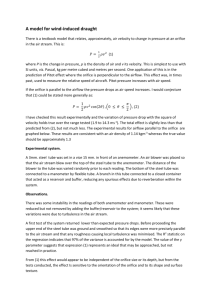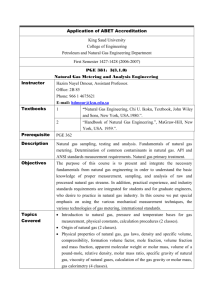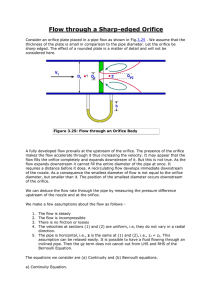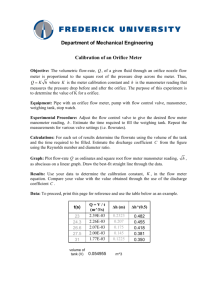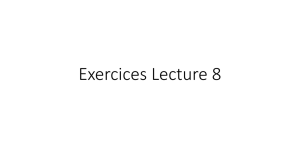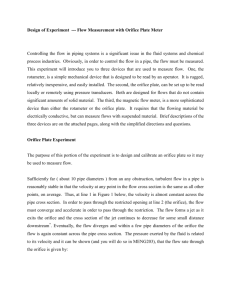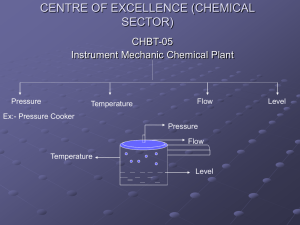Technology*. THESIS on by,Charles W.Snow, TEST
advertisement
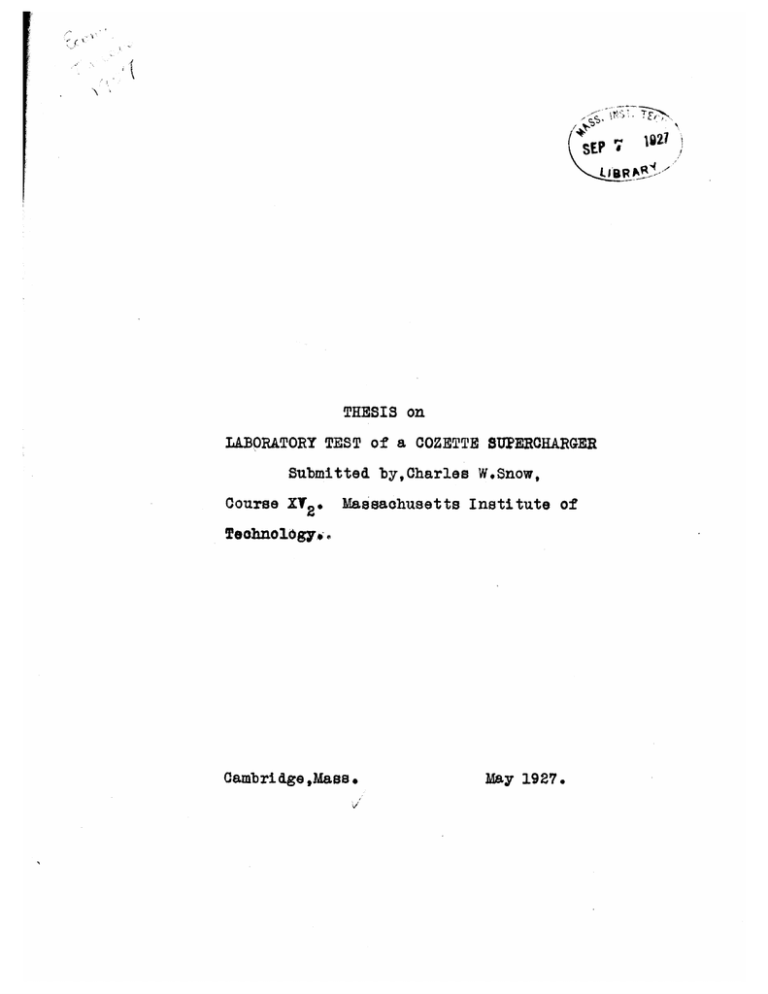
C'
N'
THESIS on
LABORATORY TEST of a COZETTE SUERCHARGER
Submitted by,Charles W.Snow,
course 1U 2 .
Massachusetts Institute of
Technology*.
CambridgeMass.
May 1927.
CambridgeMass.
May 26,1927.
Professor A.L.Merrill,
Massachusetts Institute of Technology
CambridgeMass.
Dear Sir;In
partial fulfillment of the requirements
for a degree of Bachelor of Science from the Massachusetts Institute of Technology,
I herewith
present a thesis of a"Laboratory Test of a Cozette
Supercharger".
Respectfully submitted,
Charles W.Snow.
ACINOWLEDGEMENT_
I wish to gratefully acknowledge my indebtedness to Professor C.F.Taylor for his generous
assistance and support in
the preparation of this
thesis and also my indebtedness to Professor
Buckingham and Professor Eames.
Charles W.Snow.
TABLE of CONTENTS
LETTER OF TRANSMITTAL ACGNOWLEDGMENTS
Page
SUMMARY..
.
. . . . .
.
. . .
. .
INTRODUCTION.....................eo
. .
. . . . .
1
*......
...
DESCRIPTION of the COZETTE SUPERCHARGER........
DESCRIPTION of the APPARATUS...................
6
PRECISION of MEASUREMENTS......................
7
PROCEDURE.
9
.....................................
9
999
DISCUSSION of CALCULATIONS.....................
10
ONCLUSIONS...................9...............
14
APPENDICIES........ ............
,...............
15
APPENDIX
A
RESULTS....9..........
16
APPENDIX
B
GRAPHS..*............
17
Volumetric Efficiency
No.1.
Horsepower and Overall Efficiency No*2.
Volumetrio Capacity
No..
Temperature and Pressure
No.4.
0 DIAGRAMS.*.......*....
APPENDIX
18
Supercharger Operation No.1.
Apparatus
No.2.
APPENDIX
D
DATA...................
19
APPENDIX
B
CALCULATIONS...........
25
1 5F371
1
LABORATORY TEST of a 0OZETTE SUPERCHARGER
Summary.
This thesis presents the results of a laboratory
test made upon a Cosette automobile engine supercharger at
the Massachusetts Institute of Technology.
The supercharger
used was constructed largely of aluminium and light metal
alloy weighing 21 1/2 pounds,designed to operate by direct
or geared connection with an automobile engine crank-shaft,
usually at crank-shaft speed.
The location is between the
carburetor of an engine and the intake manifold.
The theortical displacement of the supercharger
was 75.10 cubic inches of free air per revolution.
The supercharger was tested in this laboratory
by connecting it a directly through a flexible coupling to the
shaft of a 5 horsepower Sprague Electric cradle type dynamometer for the driving power and by means of various instraments for measuring pressures, temperatures eta., determinations of volume of air compressedhorsepower deliveredwork
output etc.,were made.
The results obtained were listed
and graphs were drawn to indicate the performance and efficiency of the supercharger..(See pages 1,2,3 and 4 of
Appendiced *A and B.
2
These results obtained tended to show that this
supercharger developed efficiencies both volumetric and
overall somewhat below those of some other types.
This
test also indicated that further improvement and perfection
of this type of supercharger are necessary Nefore it becomes as satisfactory as other types.
The mechanioal con-
struction was very good and unusually accuratethe moving
parts fitting closely and yet smoothly eliminating much opportunity for leakage.
During the run of the test the lubri-
eating system was apparently quite satisfactory but little
significance is
attached to this as actual runnirig con- -
ditions were not attempted.
The operation of the supercharger
was smooth enough but at high speeds considerable vibration
was developed.
3
INTRODUCTION
The use of superchargers in airplane engines was
a late development of the resent war and rose out of the fact
that at increasing altitudes the power of an airplane engine
decreases because of the lower atmospheric and hence intake
pressure.
This led to the construction of compressors of
various types for supplying ground lvel intake pressure to
the engine at high altitudes.
This led still further toward
increasing power by the use of superchargers at low altitudes
and raising the intake pressure above atmospheric.
The use of superchargers ihairplanes was so successoful that they were adopted in
racing cars to increase the
power and speed of an engine, particularly so since most
racing associations now limit the cubic capacity of automobile
racing engines, and also their use did away with the necessity
of a separate carburetor for each cylinder.
to commerical automobiles
This application
has been rather extensive abroad
but very slow in this country.
The types of superchargers whichhavebeen most generally used in this country for both airplane and automobile engines
are the centtifugal rotary blowers" which operate at high rotative speeds.
In Europe the tendency has been towards displace-
ment blowers and compressors such as the one used in this test
and other types. Cozette superchargers are well known abroad
but very little known in this country.
It is reperted that
a more advanced and improved blower than this has been used
very suecessfully abroad.
Description of the Cozette supercharger
A diagram of the operation of this supercharger is
shown under Appendix ( C ).
As may be seen it consists prim-
cipally of three essential points, a cylindrical retor, within
which is eccentrically set a smallersolid rotor slotted
lengthwise to receive the third essential, the rotating and
sliding vanes.
These vanes are held against the inside of the
rotating cylinder and thus slide back and forth in the slots
in the solid rotor as the two revolve.
The solid rator
is
mounted in the driven shaft and held in place by bearings at
each end of the case.
The cylinder is held in place by large
step bearings also used in each end of the case.
rotor
The smaller
directly rotates the larger at the same speed.
The
case which tightly encloses the outor cylinder is equipped
with a cylindrieal inlet port directly opposite the rectanglar
outlet port, as shown in the diagram.
As may be seen this is
extended part way around the blower through a rectangular
passage to permit inlet of the air to the mqximum volume
enclosed by each two vanes and the two roters.
The outlet
r5
port extends to the point where the two rotors most nearly
meet.
The volume enclosed by each pair of vanes is not
entirely open but admits upon the inlet and outlet of the
case through two parallel rectangular ports each 1 1/2"by
3/4" in
the rotating cylinder, which are so arranged as
to give full opening when exposed to the ports in the case.
Consequently the action is, that as each pair of ports in
the cylinder pass the inletair
is
admitted at atmospheric
pressure and continuies to be admitted for one fourth of
a revolution until the maximum volume enclosed by each two
vanes is attained, when the ports are shut off by revolving
in the case.
As they revolue they gradually open upon
the outlet after passing through another quarter of a turn.
Each pair of ports is exposed to the outlet for still another fourth of a turn until the minimum volume between
each pair of vanes is reached at the point where the two
rotors most nearly meet.
After passing through the last
90 degrees of rotation the ports again open upon the inlet.
Mounted directly upon one end of the driving shaft
is a small English oil' pump to be directly connected to the
main oil supply of the engine.
This provides lubrication
to the entire blower,admitting oil into a shall drilled
passage in the shaft and thence to the vane slots and moving ports through various openings.
The function of this
pump is not to pump oil directly itself but to oppose the
oil pressure of the engine and this meter the oil supplied
to the supercharger to prevent over oiling.
An adjustment
is provided to very the amount of oil admitted.
DESCRIPTION of
the APPARATUS
A diagram of the set-up of the test is shown in
Appendix
(
a
).
The amount of air compressed was calculated from
measurements by an orifice and water manometer.
Different
sizes of orifices being used for the varying speeds and
pressures.
The orifice was located in the top of a 50
gallon steel dram the purpose being to
pulsating flow of the supercharger.
break up the
The lead from the
manometer was affixed in the side of the drum below the
orifice,
From the side of the drum at the bottom an
inch and a quarter pipe led to the intake of the supercharger.
A mercury manometer was inserted in the pipe
just before the entrance into the blower for the purpose of measuring any drop in pressure there may have
been at that point.
The blower was mounted upon a
cradle bolted to a steel bed with the intake down.
A 1 1/2" pipe was srewed into a steel plate fastened
upon the exhaust port of the compressor and was about a
foot in length.
Upon the end of this pipe was a gegulat-
ing pressure valvea pressure gage and a thermometer.
The shaft was direct connected through a flexible
coupling to a 5 Horsepower Sprague Electric Cradle-type
dynamometer and the torques required measured through an
arm resting upon a Fairbanks'
scale.
The speed was taken
by a Hassler tachometer.
jSECISIO
of
IMASUREMENTS
The manometer used for measuring the drop in
pressure through the orifice was of the inclined type
using water, with differences measured on a centimeter
scale, where one centimeter on the inclined scale equaledt
1/10th of an inch of water vertically.
A small leveling
bubble was mounted on the manometer board so that very
accurate measurements could be obtained, it
being quite
possible to read accurately to .005 of an inch of water
vertically or half a millimeter on the scale.
Because
of any variation caused by irregularities of current and
voltage to the dynamometer the average of three readings
of the manometer was taken for each run.
The mercury manometer before the intake was
equipped with a 6
in scale reading to hundredths of an
inch of mercury with a variation or possible error of .01
of an inch either way making the maximum error .02 of an
inch of mercury.This> amounts to nearly .01 of a pound per
square inchwhich is negligibile.
8
The scale readings for which an average of three
was taken were accurate within 1/2 of an inch pound or
considerable less than 1 % at the lowest pressure (0#/in2 )
and correspondingly less for the higher pressures.
The tachometer used probably allowed the possibility of greatest error because of the fact that its pointed steel shaftspringlesswas inserted into a counter ounk
hole in the dynamometer shaft for its rotationtherefore
several readings for each speed were taken.
This was accu-
rate to 2 revolutions per minute which was a small factor
at 1000 R.P.M.
The pressure gage was calibrated and was accurate
to about tenths of a pound.
The effect of an error here
of a few tenths of a pound was very marked as slight increases or decreases noticeably affected the orifice manometer reading and to a less extent the speed.
An error
here of a tenth of a pound was also of great moment in
the computation of results and consequently as an error
here had by far the greatest effect all others were negligibill.
The best that could be done was to set this at
a constant pressure for each run and to maintain it at
that pressure and ;mot, attempt to vary it
other instruments.
for readings of
9
PROCEDURE
A series of runs were made at discharge pressure of
0,2,4,6 and 8 pounds per square inch gage and at speeds varying from 700 to100T and 2000 R.P.. for each pressure.
Abs
it
was impossible to so set the contrals to run at the
some speeds for different pressures no attempt was made to
do so,
the aim being to get a set of representative readings
for each pressure with the speeds as closely corresponding
as was feasible.
Because of the limits of the apparatus
no speeds of over 2000 R.P.M. were attempted.
Pressures
above 8 #/sq.in. were found impractical because at 750
R.P.M. ten pounds / sq.in. was found to be beyond the
capacity of the supercharger and at' higher speeds temperatures of between 250 and 300 degrees Fahrenheit
resultedrendering it
pressure.
impractical to make runs under such
For each run readings of the manometersscales,
speedtempa ratures and discharge pressure were taken and
for all but the discharge pressure which was kept constant
and the mercury manometers average of three readings were
taken.
10
DISCUSSION of CALCULATIONS
The formula used for computing the volume of air
blown through the orifice was that developed by the
American Society of Compressed Air Engines for differences
in pressure of less then one pound per square inch.
This
formula is as follows;
Q =
3.64
i
d
2
T H
Pm
I
=
coefficient of the orifice
d
=
diameter of orifice throat
T
=
Absolute temperature of the air before the
orifice in
H
=
- P
1
Em
in inches of water
2
pressure before the orifice #/sq.in.
P=
P2
degrees Fahrenheit
=
pressure after the orifice #/sq.in.
1 + P
2
Because the orifices used were of cast iron and
hence somewhat rougher because of small blow-holes than
other tyoes a constant of .97 was used.
11
According to the American Society of Compressed
Air Engines the K for smootl
well-rounded orifices should
be .98 or .99 Garefully constructed standard orifices were
used (see detail of orifices page
( 1 )
Appendix (
c)
In computing the capacity of the supercharger
careful measurements were made directly upon each part
and the volume per revolution was taken to be that which
would be destribed by a vane when exposed to its
maximum
Width between the two rotors which was rotated 360* abbut
a point corresponding to the center of the shaftless the
combined
stant.
exposed volume ofall the blades at any one in-
It was assumed in this method that the surfaces
of the two rotors were parallel which was not strictly
true as they are
centers.
in
circumferences about different
The error here is small however and fully with-
experimental error.
No allowance was made for a vel-
ocity head which would tend to be small also and tend to
off-set this other error.
The volumetric efficiency was computed as the
ratio of the
above two resultsflow of air through orifice
per unit time divided by theoretical capacity per unit time.
12
The brake horsepower was obtained from the
R.P.M.and torque of the dynamometer using the simple
hp = 2
n L x W where L = length of the
33,00
arm,in feet, W = scale reading in pounds and n the R.P.M.
formula
The following formula for calculating the net
air horsepower was obtained from the A.S.M.E. test code
for displacement blowers and compressors.
hp
P
2
-
= absolute intake pressure in lbs./sq.in.
absolute discharge pressure in lbs./sq.in.
Pb=
N
= .0153 P*ya
=
volume compressed, eu.ft.per min.
This is for adiabatic
compression which does
not strictly apply to this test as some heat was conducted
away through radiation and this was decreased by heat added through friction etc.,but the results are sufficiently
accurate for this test.
The overall efficiency was taken as the ratio of
these two results
Graphs of all these results were drawn and are
shown under Appendix (
)
The volumetric efficiencies obtained were rather
low compared to the N.A.C.A, Roots type blower but compare
favorably with commercial air compressors.
a trifle
higher if
These might be
a more accurate determination
capacity of the supercharger had been possible.
of the
13
It is also evident that at higher speeds such as might be
obtained when connected directly to an engine still higher
efficiencies would be obtained as the curves show increase
with R.P.M. although th.
rige is
lessening all
the time.
The dynamometer horsepower increases very markedly for increases in speed and pressurealso the air
horsepower though less so particularly.
It the low pres-
sures to be expected in actual use.
In the main the overalleffibienoeg increase with
the speed and at high speeds are apparentflysomewhat higher
than those obtained in this test although it is evident
that a limit may be reached.
Thene efficiencies are also
somewhat lower than those obtained by the N.A.C.A. Roots
blower although comparing very favorably with ordinary
displacement compressor.
14
CONCLUSIONS
The results of this test tend to show that the
efficiencies of this supercharger are rather lowthat for
best overall efficiency a discharge pressure of 6
# /
sq.in.
is best, but thatas may be expected,volumetrio efficiencies
are better at lower pressures.
From the stand point of heat-
ing, high pressures are prohibitive,particularly when accompained by high speed, although the fact is apparent from
the data that the temperature is
a function of the pressure
almost solelyheat from friction being practically negligible.
As far as speed is
concerned,higher speeds bring better ef-
ficiencies at all pressures, the one exception in the results
being probably due to an arror in
the data of the test itself,
that the most advantages speeds are around and above 2000 R.P.M.
A study of the supercharger itself shows it to be
of very accurate and probably sturdy constructionof light
weight and easy operationbuilt upon a rather simple principle
whichin more advanced models of higher efficiencies should
prove very suitable for use in connection with automobile
engines.
15
APP3NDICES
RESULTS
0# Discharge Pressure
R.P.M. Volumetric cudft.of Volumetric Air HP
Capacity
Free air Efficiency
Net
cu.ft./
min,
Dynamometer Overall
HP
Efficiency
Pumped/
min.
759
33.00
24.6
74*6
.264
1000
43.46
33*2
77.4
.421
1509
65 *
51.0
80.4
.992
2# Discharge
Pressure
778
33.8
20.75
61.9
. 1889
.473
39.03
1028
44*6
29.02
65.9
. 2663
.675
39.4
1542
67
48.7
74.6
485
1.340
36.2
4# Discharge Pressure
754
32.70
16.1
49.3
. 264
.654
40.4
1021
44*4
24.8
56.3
. 4125
.989
41.75
1470
63.85
42*9
68.75
. 744
1.603
46.4
3197
.889
36.
4825
1.213
39.75
6# Discharge Pressure
763
33.15
13 *
40.9
999
43.4
20.73
48.25
.
1205
52.35
28.47
55.1
. 581
1.522
44.75
180
18.45
52.3
68.75
1. 303
2.510
51.9
.936
11.65
8# Discharge Pressure
712
30.93
3.65
17.8
.109
1018
44.4
13.68
31.3
.4175
1.602
26.00
1218
52.9
20.28
38.82
.637
2.050
31.1
17
APPElNDIX
GRAPHS
B
St
.
--- ,!
40,
70
C)
TtF
1m
Q
v.eol-fffic 'n
Curve
owm
-8
*Ion
betwee n
ad
Volum ecaar
M
.1
D
.
-
S
-lo.
I~
1S
\
.1
LA
a
c
IS
18
APPENDIX
DIAGRAMS
0
VP
:3
rb
ga(fN*NaNa>a..w
C.4
911ZZ1117ITT71
C)1
Cp4
V
APPENDIX
DATA
D
20
Diameter of rotating cylinder
5.08"
Diameter of eccentric roto*
4.125"
Length of blades
5.12"
Thickness of Blades
.058"
Inside diameter large bearing step
2.958"
Inside diameter small bearing step
.787
Farther edge small bearing to large
bearing step
Actual diameter of orifices
1" orifice
1.0113"
3/4"
"
0.7497"
1/2"
"
0.4998"
Weight of supercharger
21.5 lbs.
Length of dynamometer arm
12.5"
2.830"
21
DATA
Barometer
29.67
Temperature
68*F.
o# Pressure
R.P.M.
Scale
Temp.
Orifice
Manometer After
Blower
1
762
28 oz.
15.1
950
2
763
28
15.1
94*
752
3
Sum 2277
28 "i
15.05
930
Ave.
759
28 oz.
15.1
940
1
1000
34 oz.
26.6
920
2
1000
34
26.6
3
1000
34
26.6
910
34.oz.
26.6
91.5*
Blower
Closed
End
Manometer Orifice
Open end
2.90
2.60
1"
2090
2.55
1"
3.22
2.28
1"
2.87
2.63
in
Sum.
Ave.
1000
1
1520
4 oz. 55.6
95:
2
1002
5 oz.
55.4
970
3
1004
6 oz. 55.2
880
290
Sum*4726
Ave.
1509
3# 5 oz. 55.4
96.7*
2f Pressure
1
775
17 oz. 10.9
118*0
2
780
17 oz. 10.9
116?
3
779
Sum*2334
17 oz. 10.9
Ave.
778
2# 17 oz. 10.9
1160
116.7*
22
DATA (con't.)
2#
R.P.M.
Pressure
Scale
Orifice Temp. Blower Manometer Orifide
Manometer after Closed Open end
Blower end
1
1030
2# 21 oz.
19.85
1150
2
1025
2# 21 oz.
19.95
1140
3
1030
2# 21.
oz. 19.95
113*
Total 3085
2.93
2.57
1"
3.13
2.37
31"
59.75
19.91
114
6 oz.
50.8
1160
4#
6 oz.
50.5
1170
1542
4#
6 pz.
50.7
1180
Total 4506
Ave. 1542
4#
6 oz.
152.0
50.67
1170
Ave.
1028
2# 21.0.
1
1514
4#
2
1540
3
4#
Pressure
1
767
3#
22. oz. 07.6
2
747
3#
21
oz. 07.6
1160
3
747
3#
24
oz. 07.5
1180
Total 2261
67
oz.
Ave.
754
22
oz. 07.6
1160
1
1022
29
oz. 14.45
1290
2
1016
30
oz* 15.0
130.
3
1025
Total 3063
Ave. 1021
30
oz. 16.06
131*
30
oz. 15.0
1300
114*0
1
1473
8
oZ.
40.75 1360
2
1458
8
oz.
40.55
136*
3
1470
Ave. 1470
7
8
oz.
oz.
40.5
40.6
136 0
1360,
2*84
2.66
1"
2.86
2*64
1"
3.06
2.44
1"?
25
Barometer
29.8
Temperature
68.5
DATA(6on't )
6#
R.P.M.
Scale
Pressure
Orifice Temperature Blower Manometer Orifice
Manometer after Blower Close end open end
1
1785 7# 1/2 oz.
58.2
1740
2
1809 7#
58*2
170*
3
1808 6# 15 1/2
68.1
168*
58.13
170*
Total 5389
Ave. 1808
750
7#
1
762
5# 14 oz. 5.8
116*D
2
763
5# 12 oz. 5.84
115*
3
764
5# 15 oz. 5.4
1240
Total
Ave.
17.04
41
5# 14 oz. 5*68
355
763
984
2.30
1"
2*80
2.70
1"
2.85
2.65
1"
2*90
2*60
1"
1180
orifice
ran.
Scale
1
996
11.2
5# 17 oz. 149
2
998
11.0
5# 18 oz. 1480
3
1004
11.0
5# 18 oz. 1500
33*2
11*0
5# 18 Oz. 149.3*
Total 2998
999
Ave.
3e20
1187 etc.
1
1199
19.0
6#
6
oz. 164*
2
1212
20.0
6#
8
oz. 169*
3
1204
18.6
6#
Total 3615
1205
Ave.
57*6
19*2
6#
5 oz. 1680
10
6
oz. 501*
oz. 1699
24
DATA (Bon't.)
8#
R.P.M.
Scale
Pressure
Blower Manometer Orifice
Orifice Temp.
Closed Open
After
Manometer
End
Blower End
1
713
36 oz.
6.8
1790
2
712
36 oz.
6.7
180*
3
711
5#
36 oz.
6.7
1810
Total
Ave. 712
5#
36 oz.
6.73
180*
1
7#
15 Os.
15.2
2120
15 oz.
15 oz.
16.16
16.15
15 oz.
15.17
219*
220*651 ,
217*-
1019
1016
2
3
1020
Total 3055
1018
Ave.
1
1212
7#
23 oz.
30.2
223*
2
1222
7#
24 oz.
30.45
2880
3
1220
7#
25 oz.
30.7
230*
24 oz.
9135
30.45
681
227*
Total 3654
Ave. 1218
2.80
2*70
1/2"
2.90
2*60
3/4"
2.58
5/4"?
2.92
25
APP!EDIX
E
CACULATIONS
a'
CALCULATIONS
1.
Volumetric capacity
Vol. displaced by rotor
5.12 x 13.36 : 68.40 in. 3
(4.125)2
5.12 x
4
Vol.
displaced by blades
5.12 x.058 x 6 x av.width
Outside dia. of large bdaring 6.938
Radius 1.969
Inside dia. of small bearing
.787
.3935
Radius
Distance between two outside edges 2.83
2.83 -
.3935 - 1.969
=.4675
Dia. of cylinder
5.08
Dia. of rotor
4.125
.955
Difference
.4775
2
Clearance 0.4775 -
.4675
= .01
Average exposed width of blades
(.4675+
.955) +
.01
.711
Vol. displaced by blades
5.12 x .058 x 6 x .711
Total vol.
blades & rotor
1.267 cu.in.
69.667 cu.in.
_WMT
F,
MPIT.,
MM"M!
N57
/
/
Dotted circle less
rotor circle timies
length represents
volume displaced per
revolution
Radius of large circle
2.53 * .4675 = 2.9973
2.9975
Vol.
3"
of large area x length
5.12 x
144.77
-
:
x 9
=
69.67
144.77
75.10 cu.in./rev.
Theoretical displacement
2.Weight of air through orifice
Compressed
= 3.64 K d2
=
Air
Society
Formula
H T
Pm
where Pl does not
exceed P 2 by more
than 1 lb.
cu.ft. air per min. at pressure P 2
K
orifice constant
d
orifice throat diameter
H
Pi - P2 in inches of water
am
=Abs.
Ti
Pm
P
temp.
before orifice
*1 P2
2
3. Constants
For 1"1 orifice and 6850 F
= 3.64 x .97 x 1.023
=
3.64 x .97 x 1.023 x 22.95
Q =
83
for
"
=
528 x
orifice
3.64 x .97 x .25 x 22.95
H
Pm
Q 20.18
for A" orifice
x 22.95
3.64 x .97 x .562
Q 45.5
H
Pm
4. Per cent of barometer pressure of pressure reduction
in pipe before blower.
0#
pressure
759 R.P.M.
Mercury head
*3
29.67
=
2.9 - 2.6
.011
=
.3in.
= 1.1%
1000 R.P.M.
Mg head a 2.95 - 2.55
= .4
in.
SW
-4 = .013 = 1.3%
29.*67
head u 3.22 - 2.28 = .94
1509 R.P.M.
.032 = 3.2%
.94:
29 .67
2
Pressure
778 R.P.M.
= .24
2.87 - .2.63
.24 : .008
29.*67
=
8
1030 R.P.M.
=.36
2.93 - 2.57
.36
29.67
=
.012
=
1.2%
1542 R.P.M.
6.13 - 2.37 : .76
.76 :n .026
29,.67
4
= 2.6%
---*Q/
Pressure
754 R.P.M.
2.84 - 2.66
.18
=
.18
.006 = .61/'
29.67
1021 R.P.M.
2.86
-
2.64
=
.22
.22 = .0074 = .74%
29.67
50
1470 R.P.M.
3.06 - 2.44 = .62
262
29
6
*s67
.021= 2.1%
Pressure
1808 R.P.M.
3.20 - 2.30 = .90
.90
29 * 67
.03
34
764 R.P.M.
2.80 - 2.70
.10
297.6
.003
= .10
.3%
U
999 R.P.M.
2.85 - 2.65
= .2
= .7%
1205 R.P.M.
2.9 - 2.6 = .3
= 1.1%
8
Pressure
712 R.P.M.
2.80 - 2.90
=
.3%
1018 R.P.M.
2.90 - 2.60 = 1.1%
1218 R.P.M.
2.92 - 2.58
= .34
1.2%
8
5. Volume of Free Air through orifice
0
Pressure
750 R.P.M.
Q= 83{j
H
Pi
15.1
-P2
-
13.1 cm.
1.31 in.
2 x 13.1 cm.
1.31 in.
/in 2
x .03613 = .0423
P 2 u 14.574
-.042
Pm "
Pl+
2
P2
=
14.532
29.106 .
2
-
-
4.553
1.31Q
83
QA
24.6 cu.ft./,im at 14.532
/in 2
14.5
24.6 x
24.6 cu.ft./min.
1
53
.09
83 x .3
1000 R.P.M.
H
H
=P
- P2
26.6
2
-
2.46 x .03613
24.6 cm.
.0889
/in
2.46 in.
2
14-574
P2
-
.089
Pl + P2
Q=83
14.485
:
29.059
:
2.46
83. x .398
=
83
: 14.530
.158
14557
63.02 x 148574
=83x
.398
33.2 cu.ft./Wim.
58
Pressure
0
1509 R.P.M.
P1 -
53.4 cm.
P 2 = 55.4 - 2
=
5.34 x .03613
/in
.1874
=
5.34 in.
2
P2 = 14*574
*187 =
-
P1+
/in2
14.387
P2
-
:
28.961
2
83
/in
=69
83 x
8
S50.4 x 1457
2
14.481
2
.607
cu.ft. air/min.
51.0
Pressure
778 R.P.M.
=
Pi - P2 w 10.9 - 2
8.9 cm.
/in
.89 x .03613 : .032
=
P2
F1 -r P2
Q
.89 in.
2
14.574
-
QA
=
.032 v 14.542
.29
.116
:
83 1
4.5
.0611- 83 x .25
83\
20.75 correction negligible
20.75 ft. 3 /min.
1028 R.P.M.
Pl-P2 = 19.91
2
-
=
17.91
.0646
1.79 x .03613
=
/in 2
14*574
P2
-
Pl i
P2
2
.065
14.509
29o.083
2
14.542
1.79 in.
535
2
Pressure
1028 R.P.M.
lZ54
83
=
=
83 x .35
:
29.02
23
83
8 x .35
cu.ft.air/min.
1542 R.P.M.
Q
H
Pi
jH
83
m
=
P2
-
50.67 - 2
4.87 x .03616
=
=
48.67 cm. = 4.87 in.
.176
P2 : 14*574
-
P1+
.176 = 14.398
-
P2
4
:
28.972
2
2
14.486
1 46
S83 ~\F 4.o87
: 83 Fo3364
=
:
48.1 x 14574
48.7
83 x .580
cuoft./min.
Pressure
754 R.P.M.
Pi - P 2
=
7.6 - 2 * 5.6 cm. = .56 in.
.56 x .03613 :
.0199
P2 = 14*574
-
P1 + P 2
q
.020
=
14.554
- 29.128
83
56
14.564
83 f.03848
=
83 x .194
Q 16.1 negligible corwections 16.10 cu.ft./min.
4
Pressure
1021 R.P.M.
Pi - P 2 u
15.0 -
2
=
13 cm.
" 1.3 in.
-
54
1.3 x .03613
=
P2
=
.047
14'.574
Pl +- P 2
2
=
.047
-
I
14.527
29.101
:
14.551
83
.0894
2
1.
S3
83 x .298
14. 54
Q
*
24.74 x
24.8 cu.ft./min.
1470 R.P.M.
- P2 a 40.6 - 2
P
=
3.86 in.
38.6
/in
3.86 x .03613 : .1395
=
P2
14.574
-
Pl + P2
2
Q
6
14.434
.140
83
Barometer
-
=
=
515
42.9 cu.ft./min.
=
56.13 cm.
=
5.613 in.
.201
14.638
-
6
: 83 x
29.8 x .4912 : 14.638
P2 : 58.13 - 2
=2
14.504
83
3.86
5.613 x .03613
P2
:
29.008
2
Q 42.75 x 14.574
14.3O4
1808 R.P.M.
Pressure
P1
2
.201 = 14.437
P1 + P2
2
Pressure
:
29.075
2
: 14.538
1808 R.P.M.
Q 83
5.613
14, 539
83
3861= 83 x .621
-
=
51.6 x 14.638
52.3 cu.ft./min.
763 R.P.M.
Plo- P2= 5.8 -
2 x 3.8
.38 x .03613
.01372
.38 in.
14-638
P2
-
1i+
.014
:
P2
=83
14.624
:
29.262
83
Q
=
14.661
83 \*.02594
.38
x .161
=
13.50 cu.ft.air/min.
999 R.P.M. at Bar
=
29.67
Q
=
Pl - P 2
11.07
.907 x .03613
9.07
= .907
-
2
=
.03278 lbs/in 2
in.
14*574
P2
14.541
-.033
1 + P
2
: 29.115
14 * 558
2
.907
.0622 : 83 x .2494
83
T145
Q=83
Q 20.7 x 14.574
cu.ft./min.
20.73
;
14 *541
1205 R.P.M.
=
P1 - P2
19.2 - 2 a 17.2 cm.t
1.72 x .03613
P2
Q
=
1.72 in.
.0621
14-538
-.062
=
2+ :
29.214
83
14.576
1.72
14.607
=
14.607
83
.1178
83 x .341
I I . - 'IN
56
8
Q -28.34
x
Pressure Bar
=
cu.ft./min.
28.47
14*638
29.67 a 14.574
712 R.P.M.
}in. orifice
Q 20.18
Pl - P2
=
=
0.473 x .03613
P2
=
6.73 - 2 0 4.73
.473 in.
.0171
14.574
.017
-
Pl + P2
2
14.557
3
29.131
472
-
:
14.566
: 20.18
20.18
Q 20.18 x .18 : 3.6 5
.03228
cu.ft./min.
1018 R.P.M.
P1 - P 2
=
15.17
1.617 x .03613
P2=
P1 + P 2
1.317 in.
.04755
14.522
:
29.096
2
45.5
317
13.65
14.574
:
8
=
=
14,574
-.048
Q
2 a 13.17
-
-
14.548
:
45.5
13.68
.0905
cu.ft./min.
Pressure
1218 R.P.M.
Pl - P2
30.45
2.845 x .03613
-
2 = 28.45
.1029
45.5 x .3
2.845 in.
14.574
P2
-. 103 :
1 + P2
2
-
45.5
Q
6
=2
14.471
29.045
2
14.523
.196
45.5
2845
x .443
.43
Q46.6
6.6x
~
x
X14.471
=
cu.ft./min.
20.28
Volumetric efficiencies
Capacity per revolution :.04346 cu.ft./rev.
0
Pressure
759 R.P.M.
capacity =
33.24 cu.ft./min.
Air volume by orifice : 24.6 cu.ft./min.
Manometer correction before blower 1.1%
=
24.6 x 101.1
24.9=
24.9 cu.ft./min.
74.9%
1000 R.P.M. capacity
74.9%
=
Correction
43.46 cu.ft./min.1.3%
33.2
Orifice vol.
-
ay3
33.2 x 101.3
774%
1509 R.P.M.
Capacity :
65.5,
correction
*
3.2%
Orifice vol. a 51
526 5804%
51 x 103.2
2
Pressure
778 R.P.M.
capacity :
Orifice vol.
2m
20.75 x 100.8 **
20.75
x20.9
6*
33.8
correction
cueft./min.
.8%
:
61,9%
5,
1028
R.P.M.
Orifice vol.
-
29.02 x 101.2
=
1542 R.P.M.
=
correction
29*4
33.8
=
=
48.7
1.2%
65.9%
67
2.6%
Correction
=
:4995
48.7 x 102.6
74.6%
Pressure
capacity :
754 R.P.M.
=
Orifice vol.
15.78
1021 R.P.M.
:
1470 R.P.M.
=
Orifice vol.
25.0
=
capacity
42.9 x 102.1
48.8%
correction .74%
24.8
24.8 x 100.74
.61%
correction
4404
capacity :
Orifice vol.
32.54
15* 87
15.78 x 100.61 a
6
44.6
29.02
Capacity
Orifice vol.
4
=
capacity
63.85
correction 2.1%
42.9
43*9
=
68.75%
63.85
-
Pressure
capacity :
1808 R.P.M.
=
Orifice vol.
52.3 x 103
52.3
:
Capacity
=
=
Orifice vol.
29.67 x 100.3 999 R.P.M.
Orifice vol.
20.73 x 100.7
Correction 3%
53.9
=
764 R.P.M.
78,45
29.67
=
33.15
Correction 3%
3= 5
Capacity
=
68.75%
4_0.9%
=
20.73
20.9
43.4
43.4
Correction
=
.7%
:48_.25%
U
~-
39
1205
8#
R.P.M.
capacity
Orifice Vol.
=
28.47 x 101.1
=
52.35
-
28.47 correction
1.1%
=55.1%
28.8
02.35
Pressure
712
R.P.M.
capacity
=
Orifice Vol.
=
3.65
3.65 x 100.3
-
3.66.
30.93
correction
= .3%
11.8%
-
30.93
1018
capacity
R.P.M.
=
44.2
Orifice Vol.
=
13.68
13.68 x'100.1
=-
13.82
correction t 1.1%
=
31.3%
44*2
1218
R.P.M.
=
capacit yr
=
Orifice Vol.
52.9
20.28
x
101.2
= 20.53
52.9
7.
Brake Hovsepower.
Length of arm
12.5 in.
Pressure
759
Scale
R.P.M.
= 2
HP
=
1# 1202
x 12.5 x 759
x
28
x 16
33,000 x 12
=:
.00239
12
-
x
= 2802
759 x 28
16
.0001983 x 759 x 28
16
=
.264 HP
=
38.82%
A
40
1000
R.P.M.
=
1009
.0001983 x 1000 x 24
16
= .421 HP
R.P.M.
=
.0001983 x 1509 x 58
=
.992 HP
16
778
R.P.M.
1028
.0001983 x 778 x 49
16
.473
=
HP
R.P.M.
.0001983
1542
x 1028 x 53
16
=
.675 HP
R.P.M.
.0001983
x 1542
=
x 70
1.340
HP
16
4#
Pressure
754
R.P.M.
.0001983 x 754 x 54
16
1021
=
.505
R.P.M.
.989 HP
.0001983 x 1021 x 78
1470
R.P.M.
.0001983
6#
1808
x 1470
x 88
16
=
1.603
HP
Pressure
R.P.M.
.0001983 x 1808 x 7
763
HP
=
2.510
HP
=
.889
HP
R.P.M.
.0001983 x 763 x 94
16
999
R.P.M.
.0001983
1205
x
8#
Pressure
712
R.P.M.
1218
HP
1.213
R.P.M.
x 102
16
.0001983 x 1205
1018
=
999 x 98
16
.0001085
x 112
.0001983
x 1018
m 1.522
x 106
16
HP
-
.936
=
1.602
HP
R.P.M.
x 127
16
HP
R.P.M.
x 1218
.0001983
2.050
x 136
HP
16
8
Horsepower
2# Pressure
A.S.M.3. Formula
hp
778
=
.0155
a
R.P.M.
hp
=
p1
-
14.574
14.574
=
029
a
.0153 p ( before blower) v (free air)
.34 in.of Hg
hp
r
p
-
-
=
.118
.75%
(14.574)
.24 x 4912
=
=
= 14.469
.118
14.456
ii
.0153
x 14.456 x 20.75
.29
42
log
16.574
= 1.21950
log
14.456
= 1.15999
=
.05051.29
log
hp
1028
x
=
.014761
=
.0153
.017258
=-1.0405
x 20.75
x 14.456
x .0405
=
.1859
R.P.M.
p1
=
14.534
p
=
14.397
=
29.02
1
v
log
p2
-
x .4912 =
.36
log
16.574
=
1.21940
log
14.397
=
1.15827
14.574
-.178
.06122
=
.0611 x .29
hp
1042
=
.0153
.017729
x 14.396
1.0416
=
x
29.02
x .0415 =.2663 HP
R.P.M.
P1
P1
correction
-
=
= .0
.4912 = .76 = .3737 #/inz
14.574 - .3737 =
log
16.574
=
1.21950
log
14*2
=
1.15229
.0672
x
.29
14.200
=
.019491
x 1.0459
2t
Pressure
1042
R.P.M.
=
hp
4#
.0153
x 14.2 x 48.7 x .0459
= .485 HP
Pressure
754
= 14.574 =
p1
p
.4912
x .18
= .0884
= 14.486
1
log
18.574 =
1.26891
log
14.486 =
1.16095
.10706 x .29 = ..31047
=
=
hp
1021
=
1.10727
.0153
x
1.0747
14.486
16.1 x .041 = .2590
x
R.P.M.
.4912
=
.22
x
p1 =
14.574
vi =
24.8
.108
.108
=
14.466
log
Pa = log 18.574
=
1.26891
log
log 14.466
=
1.16035
.10856
.10856
hp
1470
=
.0153
R.P.M.
S1
.62
=
x .4912
14.574
18.874
14.271
-
=
=
.303 =
= .4125 HP
.3027
14.271
42.9
=
1.26891
=
1.15445
.11446 x .29 = .033194
1.0795
= .0153
x 14.271 x 42.9 x .0795 = .744
=
hp
= 1.0752
x 14.266 x 24.8 x .0703
v1
log
log
= .03 1482
x .29
44
6#
Pressure
1808
=
Bar
29.8
=
14.638
R.P.M.
.4912 x .9
=
.
=
.433
20.638
= 1.31467
"
14.205
= 1.15244
= 1.0896
1.1146
= .0153 x 14.205 x 52.3 x .1146
763
.433 = 14.205
x .29 = .04704677
.16223
hp
-
52.3
log
x
14.638
=
1.303 ER
R.P.M.
.4912 x .2 = .09824
=
P
14.574 N1
=
.098
=
14.476
13.5
log
.20574
= 1.31332
"?
14.476
= 1.16065
.15267
=
x .29
= .0442743
1.1073
= .0153 x 14.476 x 13.5 x .1070
hp
999
=
.3197 HP
R.P.M.
.4912 x .2 = .04912
14.574
-
.049 = 14.525
v1 = 20.73
log P = log
20.574
= 1.31332
log
14.525
= 1.16112
.15220 x 29 = .044138
=
hp
=p
1.1070
.0153 x 14.476 x 20.73 x .1073
= .4825 HP
Pressure
1205
R.P.M.
=
.4912 x 3
=
P1
14.638
=
x
.14736
.147
-
= 14.491
28.47
log.
20.638
= 1.31467
"t
14.491
= 1.16109
.15358 x .29
=
hp
=
.04454
1.1080
=
= .681 HP
.0153 x 14.491 x 28.47 x .1080
Pressure
712
R.P.Ivi.
= .04912
.4912 x 10
P1
= 14.574 - .049 =
v
log
P2
14.525
= 3.65
= log 22.574
"
14*525
= 1.35361
= 1.16252
.19149
= .05554
= 1.1364
hp
=
1018
.109 HP
R.P.M.
.4912 x.3
=
= .14736
i4.574
Vi
=
.147
= 14.427
13.68
log 22.574
=
1.35361
log 14.427
=
1.15919
.19442 x .29
hp
=
.0453 x 14.405 x 3.65 x .1364
= .05638
= .0153 x 14.427 x 13.68 x .1386
=
= 1.1386
.4175
46
Pressure
8 #
R.P.M.
1218
.4912 x
P
=
l og 22 .574
"
.167
14.574
=
v
14 .407
.34
= .167
=
14.407
20.28
=
1.35361
=
1.15867
.19504
x
.29
= .05656
= 1.1391
hp
=
.0153 x 14.407
x 20.78
x .1391
=
.637 HP
47
Appendix
Biblography
A.S.M.E. Power Test Codes
Test code for Disptacement Blowers and Compressors
N.A.C.A. Test of Roots Type Airplane Engine
Supercharger.
